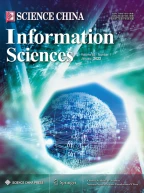138Accesses
3Citations
This is a preview of subscription content,log in via an institution to check access.
Access this article
Subscribe and save
- Get 10 units per month
- Download Article/Chapter or eBook
- 1 Unit = 1 Article or 1 Chapter
- Cancel anytime
Buy Now
Price includes VAT (Japan)
Instant access to the full article PDF.
References
Rodriguez M G, Leskovec J, Krause A. Inferring networks of diffusion and influence. Proceedings of the 16th ACM SIGKDD International Conference on Knowledge Discovery and Data Mining, Washington DC, 2010. 1019–1028
Rodriguez M G, Balduzzi D, Schölkopf B. Uncovering the temporal dynamics of diffusion networks. In: Proceedings of the 28th International Conference on Machine Learning, Bellevue, 2011. 561–568
Amin K, Heidari H, Kearns M. Learning from contagion (without timestamps). In: Proceedings of the 31st International Conference on Machine Learning, Beijing, 2014. 1845–1853
Sefer E, Kingsford C. Convex risk minimization to infer networks from probabilistic diffusion data at multiple scales. In: Proceedings of 2015 IEEE 31st International Conference, Seoul, 2015. 663–674
Dou P, Du S Z, Song G J. Inferring diffusion network on incomplete cascade data. In: Proceedings of the 17th International Conference on Web-Age Information Management, Nanchang, 2016. 325–337
Zong B, Wu Y H, Singh A K, et al. Inferring the underlying structure of information cascades. In: Proceedings of 2013 IEEE 13th International Conference on Data Mining, Brussels, 2012. 1218–1223
Lokhov A Y. Reconstructing parameters of spreading models from partial observations. In: Proceedings of the 29th Conference on Neural Information Processing Systems, Barcelona, 2016. 3459–3467
Kempe D, Kleinberg J, Tardos E. Maximizing the spread of influence through a social network. In: Proceedings of the 9th ACM SIGKDD International Conference on Knowledge Discovery and Data Mining, New York, 2003. 137–146
Khuller S, Moss A, Naor J S. The budgeted maximum coverage problem. Inf Process Lett, 1999, 70: 39–45
Acknowledgements
This work was supported by National Natural Science Foundation of China (Grant No. 61572041), Beijing Natural Science Foundation (Grant No. 4152023), National High Technology Research and Development Program of China (863 Program) (Grant No. 2014AA015103).
Author information
Authors and Affiliations
Key Laboratory of Machine Perception (MOE), Peking University, Beijing, 100871, China
Peng Dou, Guojie Song & Tong Zhao
- Peng Dou
You can also search for this author inPubMed Google Scholar
- Guojie Song
You can also search for this author inPubMed Google Scholar
- Tong Zhao
You can also search for this author inPubMed Google Scholar
Corresponding author
Correspondence toGuojie Song.
Additional information
Supporting information Appendixes A–F. The supporting information is available online at info. scichina.com and link.springer.com. The supporting materials are published as submitted, without typesetting or editing. The responsibility for scientific accuracy and content remains entirely with the authors.
Electronic supplementary material
Rights and permissions
About this article
Cite this article
Dou, P., Song, G. & Zhao, T. Network topology inference from incomplete observation data.Sci. China Inf. Sci.61, 028102 (2018). https://doi.org/10.1007/s11432-017-9154-1
Received:
Accepted:
Published:
Share this article
Anyone you share the following link with will be able to read this content:
Sorry, a shareable link is not currently available for this article.
Provided by the Springer Nature SharedIt content-sharing initiative
